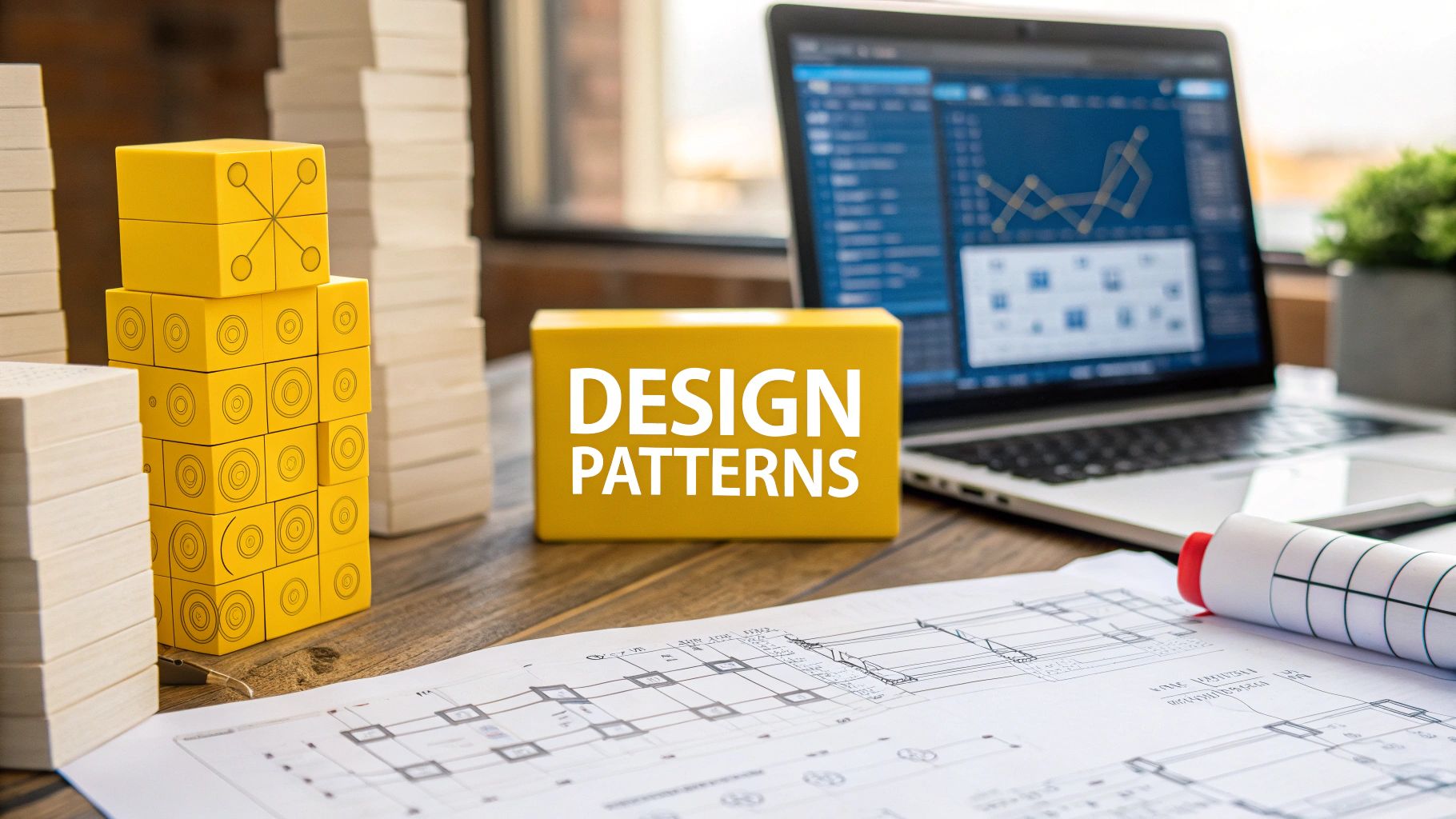Software Architecture Design Patterns: A Complete Guide

Why Software Architecture Design Patterns Matter Today
Imagine trying to build a modern skyscraper without blueprints. You'd be relying on guesswork and verbal instructions, likely ending up with a chaotic, unsafe, and unsustainable structure. The early days of software development often felt just like this—unstructured, difficult to maintain, and prone to collapse under the weight of new features or user demand. Software architecture design patterns emerged as the industry's essential blueprints to bring order to this chaos.
Think of these patterns as proven recipes that solve common problems in software design. Just as a master chef relies on fundamental techniques, a skilled developer uses patterns to build a reliable foundation. These aren't rigid solutions but adaptable frameworks that provide a shared vocabulary for making sound architectural decisions. This common language is vital, allowing development teams to collaborate efficiently on complex systems.
From Academic Concepts to Industry Standards
The concept of using patterns didn't start with software. It was inspired by architect Christopher Alexander's 1977 book, A Pattern Language: Towns, Buildings, Construction, which detailed 253 patterns for architectural design. This idea heavily influenced the "Gang of Four" (GoF), four software engineers whose 1994 book defined 23 foundational patterns for object-oriented software. These concepts quickly became industry cornerstones. A 2020 study revealed that 62% of developers globally use at least one GoF pattern, with over 70% of senior developers in major markets like the US and UK reporting their regular use. You can learn more about the history and adoption of design patterns.
The Power of a Shared Blueprint
Using established patterns offers major advantages beyond just writing clean code. It provides a strategic framework for building applications that are not only functional today but also resilient and scalable for the future.
This simple visualization shows how patterns are categorized based on their purpose:
As the diagram illustrates, patterns are typically grouped into Creational, Structural, and Behavioral categories. Each group addresses a different set of challenges in software construction. This classification helps architects and developers quickly find the right type of solution, whether they need to manage object creation, compose larger structures, or define how objects communicate.
By mastering these patterns, you are not just following best practices; you are equipping yourself with a powerful toolkit for several key outcomes:
- Improved Maintainability: Well-architected code is easier to understand, debug, and modify. When a new developer joins a project, a familiar pattern like Model-View-Controller (MVC) immediately clarifies the system's structure.
- Enhanced Scalability: Patterns like Microservices or Load Balancer are designed specifically to handle growth, ensuring your application can perform reliably as user traffic increases.
- Increased Reusability: Patterns promote the creation of decoupled components. These components can be reused across different parts of an application or even in future projects, saving significant development time and effort.
Ultimately, understanding software architecture design patterns is about making the leap from being a coder to an architect—someone who builds systems designed to last, adapt, and succeed.
From Monolithic Giants To Flexible Microservices
Early software architecture wasn’t always a model of elegance. Think of the first software systems as a company operating inside a single, enormous warehouse. Every department, from manufacturing to sales to accounting, works in one giant room. It’s functional at first, but if you need to update one production line, you risk disrupting the entire operation. This is the core idea behind monolithic architecture: a single, unified unit where all components are interdependent and tightly coupled.
For decades, this was the standard way to build software. It was relatively simple to develop and deploy in the beginning. However, as applications became more complex, that "warehouse" started to feel cramped and chaotic. A small bug in one part of the code could crash the entire system. Updating a single feature meant redeploying the whole application—a process that was both risky and slow. Developers often found themselves tangled in a complex web of code, where changing one thing had unintended consequences elsewhere. This rigidity became a major obstacle for businesses that needed to adapt and grow.
The Evolutionary Leap Toward Modularity
The move away from these monolithic giants was a gradual evolution, not an overnight revolution. The history of software architecture design patterns follows this journey, with roots stretching back to the 1960s and 70s alongside structured and object-oriented programming. While monoliths were the norm in the late 1960s, the 70s introduced more modular ideas like microkernel and event-driven designs. "Software architecture" as a formal discipline gained recognition in the 1990s, as key concepts were documented and shared. Today, its importance is undeniable: a 2022 survey found that 83% of enterprises use design patterns to manage complexity and scale their systems. You can see a detailed timeline of these architectural milestones to understand the journey from early concepts to modern practices.
The following visual shows the key stages of this architectural evolution over time.
This diagram clearly shows the shift from simple, single-layer systems to the distributed, multi-part architectures we use today. Each new stage, from client-server to service-oriented architecture (SOA) and finally to microservices, was a direct answer to the shortcomings of the previous one. The main drivers were the need for better scalability, improved resilience, and more agile development.
Rise of the Distributed System
The arrival of the internet and, later, cloud computing, put this evolution into high gear. Suddenly, applications had to serve millions of users around the world—a task that monolithic systems just couldn't handle. This pressure led to new software architecture design patterns that were built around distribution and decentralization.
Two key patterns emerged from this shift:
- Service-Oriented Architecture (SOA): This was an important middle step. SOA broke down monolithic applications into a collection of separate services that communicated over a network. While an improvement, it often depended on a heavy, central component called an Enterprise Service Bus (ESB), which could create its own new bottleneck.
- Microservices Architecture: Taking the core idea of SOA even further, microservices architecture suggests building an application as a collection of small, independently deployable services. Each service is designed around a specific business function and can be developed, deployed, and scaled on its own. Companies like Netflix and Amazon adopted this pattern to achieve incredible scale and rapid innovation.
This transition marks a fundamental change in how we think about software—moving from building one giant, perfect machine to assembling a flexible and resilient system from many smaller, specialized parts.
5 Essential Patterns Every Developer Should Master
Think of your development knowledge as a toolkit. Just like a master carpenter has specialized tools for different jobs, a skilled developer needs a versatile set of software architecture design patterns. Each pattern is a proven solution to a common problem, refined over years of use in the industry. Moving beyond theory, mastering these foundational patterns is about building your intuition—knowing which tool to pull out at the right time to build systems that are robust, maintainable, and scalable.
This section provides a practical overview of core patterns you'll encounter constantly. We'll explore what they do, when to use them, and just as importantly, when to avoid them. For a closer look at applying these concepts in real-world scenarios, our guide on custom web application development offers deeper insights into building tailored solutions.
The Foundational Trio: Layered, MVC, and Repository
Many applications, especially large enterprise systems, are built upon a few core architectural patterns that work together to create a logical and organized structure.
Layered Architecture (N-Tier): Imagine a multi-story building where each floor has a specific purpose—offices on one, residential on another, and retail at the bottom. The Layered pattern organizes code in a similar way, typically into a Presentation (UI) layer, a Business Logic layer, and a Data Access layer. This separation of concerns is its greatest strength. A change in the database layer, for example, doesn't require rewriting the user interface. This makes the system far easier to maintain and update.
Model-View-Controller (MVC): This is the workhorse of modern web development. It divides an application into three interconnected parts. The Model manages the data and business rules. The View is what the user sees and interacts with. The Controller acts as the traffic cop, receiving user input and telling the Model and View what to do. This separation allows UI designers and backend developers to work on their respective parts in parallel with minimal friction.
Repository Pattern: This pattern is a data access specialist. It acts as a mediator between your business logic and the data source (like a database). Instead of writing database queries directly in your business logic, you communicate with a "repository" that handles all the data operations. This abstracts away the complexity of data storage, making it simple to swap out a database or add a caching layer without disrupting the core application logic.
Behavioral and Creational Patterns: Managing Logic and Objects
Beyond high-level architecture, other patterns solve more specific problems related to how objects interact and how they are created.
The image below from Refactoring.guru provides a great visual catalog of many popular design patterns, categorized by their purpose.

This visual guide helps developers quickly identify potential solutions by grouping them into Creational, Structural, and Behavioral categories, making it easier to navigate the vast landscape of available patterns.
Observer Pattern: Picture a newspaper subscription. You subscribe (observe) and automatically receive updates (new editions) without having to check the newsstand every day. In software, this pattern allows an object (the "subject") to notify a list of dependent objects (the "observers") of any state changes. It’s perfect for creating responsive UIs where multiple elements need to update when a single piece of data changes.
Singleton Pattern: This pattern ensures that a class has only one instance and provides a global point of access to it. It’s useful for managing shared resources like a database connection pool or a logging service. Use it with caution, as global state can make code harder to test and debug, introducing hidden dependencies.
Factory Pattern: Imagine a factory that can produce different types of vehicles—cars, trucks, motorcycles—based on an order. The Factory pattern does something similar for objects. It provides a central method for creating objects without specifying the exact class of object that will be created. This makes your code more flexible, as you can add new object types without changing the code that creates them. This approach is fundamental to building adaptable and decoupled software architecture design patterns.
To help you decide which pattern fits your needs, the following table compares their key characteristics.
Core Architectural Patterns Comparison
A comprehensive comparison of essential design patterns including their use cases, benefits, complexity levels, and ideal project types
| Pattern Name | Primary Use Case | Complexity Level | Best For | Avoid When |
|---|---|---|---|---|
| Layered (N-Tier) | Separating concerns in large applications | Low to Medium | Traditional enterprise applications, monolithic systems | Microservices or applications requiring very low latency |
| Model-View-Controller (MVC) | Organizing UI-focused applications | Medium | Web applications, GUIs | Simple command-line tools or backend-only services |
| Repository | Decoupling business logic from data storage | Low to Medium | Applications with complex data access or multiple data sources | Simple projects with minimal data interaction |
| Observer | Notifying multiple objects of state changes | Low | Event-driven systems, UI frameworks, real-time data feeds | Simple, linear workflows without multiple listeners |
| Singleton | Ensuring a single instance of a class | Low | Managing shared resources like loggers or database connections | Multi-threaded applications where state can become an issue; most testable systems |
| Factory | Creating objects without specifying the exact class | Low to Medium | Systems where new object types are added frequently | Simple applications where object creation logic is not complex |
This table shows that while some patterns like Layered and MVC are great for structuring entire applications, others like Observer and Factory solve more targeted problems within the codebase. The key is to match the pattern's strengths to the specific problem you are trying to solve.
Cloud-Native Patterns For Modern Applications
The move to cloud computing wasn't just about finding a new place to run old software; it completely changed how applications are built. The software architecture design patterns that worked for predictable, on-premise systems started to crack under the pressure of global scale, non-stop uptime, and fast development cycles. This challenge led to a new set of cloud-native patterns created specifically for the dynamic, spread-out nature of the cloud.
This is where concepts like microservices, serverless functions, and event-driven architectures come into play. They are the essential blueprints for building applications that can support millions of users and, more importantly, fail gracefully without taking the entire system down. This evolution follows the path of technology itself. Research highlights a clear trend: after client-server models were popular in the '90s, the rise of the web pushed MVC to over 60% adoption by 2010. Now, with the cloud as the standard, a 2023 study found that 53% of global IT leaders see microservices as fundamental to their strategies. You can learn more about how architectural needs have evolved with technology.
The Microservices Revolution
Think of a traditional application as a large restaurant trying to cook every dish on a huge menu in one giant kitchen. If one cooking station gets backed up, the whole operation slows to a crawl. This is a monolithic application. Now, imagine a modern food court. Each stall is an expert in one type of food—tacos, pizza, or sushi—and runs on its own. If the taco stand runs out of guacamole, it doesn't stop the pizza place from serving customers. This is the central idea of microservices architecture.
Pioneered by companies like Netflix and Amazon out of necessity, this pattern structures an application as a group of small, independent services. Each service is organized around a specific business function, has its own database, and can be developed, deployed, and scaled on its own. This model provides remarkable flexibility and resilience, but it also creates new challenges in communication and data management between services.
Key Enablers of Cloud-Native Architecture
To make these distributed systems work together smoothly, several supporting patterns have become crucial. These patterns are the foundational pieces that allow loosely connected services to function as a single, coherent application.
The reference architecture below from AWS shows how different cloud services can be combined to create a strong, scalable application.

This diagram shows how elements like API gateways, load balancers, and container services aren't just extras but are central to modern architectural design. They deliver the necessary routing, scaling, and management functions.
Here are some of the critical patterns that make systems like this work:
- API Gateway: This acts as a single front door for all client requests. It directs requests to the right microservice, manages authentication, and can bundle responses from multiple services. This keeps the client-side simple and shields backend services from direct contact.
- Circuit Breaker: This pattern stops a single failing service from triggering a domino effect of failures across the system. If a service stops responding, the circuit breaker "trips," rerouting traffic or sending a default response. This gives the failing service a chance to recover without being flooded with more requests.
- Event-Driven Architecture: Instead of services directly calling each other, they communicate without direct links by producing and consuming events. For example, when a user places an order, an "OrderPlaced" event is sent out. The payment, shipping, and notification services can all listen for this event and act on it independently. This disconnects the services and makes the entire system more durable.
- Serverless Functions (FaaS): This pattern pushes abstraction even further. Developers write small, single-purpose functions that run in response to specific triggers, like an API call or a file upload. The cloud provider handles all the underlying servers and infrastructure, letting developers concentrate solely on their code. This is perfect for event-driven tasks and can be very cost-effective since you only pay for the time your code is actually running.
Adopting these modern software architecture design patterns doesn't have to be an all-or-nothing choice. Many successful systems use a hybrid model, carefully breaking off pieces of a monolith into microservices or using serverless functions for specific, high-demand tasks. The goal is to understand the trade-offs and pick the right pattern for the job, acknowledging that the added complexity of a full cloud-native approach might be unnecessary for simpler projects.
How Industry Giants Implement Patterns at Scale
It’s one thing to talk about software architecture design patterns in theory, but seeing them work at a massive scale is where their real value becomes obvious. How does Spotify manage millions of simultaneous song streams? How does Uber handle the constant flow of real-time location data from drivers and riders all over the world? The answer is in the practical application of architectural patterns built to solve specific, high-stakes problems.
These companies didn't adopt complex patterns like Command Query Responsibility Segregation (CQRS) or Event Sourcing because they were trendy; they did so out of need. As their user bases expanded into the millions, conventional monolithic architectures simply couldn't handle the load. The performance needs for read-heavy actions (like browsing playlists) and write-heavy actions (like saving a new playlist) demanded a more specialized approach. This led them to patterns that separate these functions, allowing each to be scaled and tuned independently.
Behind the Scenes at Netflix and Uber
Major tech companies frequently share their architectural journeys, offering lessons for everyone. Netflix, for instance, is a prime example of evolving architecture, having transitioned from a single monolith to a globally distributed network of microservices. Their engineering blog often explains how they solve problems related to resilience and scale.
The image below, from the Netflix Technology Blog, shows their focus on continuous architectural improvement and problem-solving.

This shows that for companies operating at this level, architecture isn't a fixed blueprint but a constant process of adjustment and refinement.
Uber's architecture is another compelling case study. To handle the intricate web of interactions between riders, drivers, and payments—a process that involves many services—they needed a way to guarantee transactions would complete reliably without a single, central database. This is a well-known distributed systems challenge, which they addressed by using the Saga pattern.
Here’s a breakdown of how these patterns solve real-world problems at scale:
- Command Query Responsibility Segregation (CQRS): This pattern splits the models for updating information (Commands) from the models for reading information (Queries). Spotify could use this to fine-tune its music discovery engine (a read-heavy operation) separately from its user profile management system (a write-heavy operation). This ensures that a spike in users searching for music doesn’t slow down someone trying to update their account details.
- Event Sourcing: Instead of only saving the current state of data, Event Sourcing records every change as a sequence of events. For an e-commerce site, this creates an unchangeable log of every "ItemAddedToCart," "PaymentProcessed," and "ItemShipped" event. This provides a full audit trail, which is critical for debugging, running analytics, and restoring the system after a failure.
- Saga Pattern: This pattern handles long-running transactions that touch multiple microservices. When you book a ride with Uber, a Saga coordinates separate transactions for charging your card, alerting a driver, and updating the trip status. If one step fails (like a payment issue), the Saga triggers compensating actions to undo the previous steps, maintaining data consistency across the entire system.
The following table provides more examples of how major companies apply these patterns to overcome significant challenges.
Enterprise Pattern Implementation Examples
Real-world examples of how major companies implement specific architectural patterns, including their challenges and outcomes
| Company | Pattern Used | Problem Solved | Scale Achieved | Key Lessons |
|---|---|---|---|---|
| Netflix | Microservices | Moved from a monolithic architecture to improve scalability, fault tolerance, and development speed for its global streaming service. | Serves over 270 million subscribers worldwide with high availability. | Decoupling services is key for resilience. A failure in one service (e.g., recommendations) shouldn't bring down the entire platform (e.g., streaming). |
| Uber | Saga | Needed to ensure data consistency for complex, multi-step transactions (booking, payment, driver dispatch) across different services without a single point of failure. | Manages millions of trips daily across a distributed system. | Compensating transactions are crucial for maintaining consistency when a step in a long-running process fails, preventing data corruption. |
| Spotify | CQRS | Faced performance bottlenecks with a system where read-heavy operations (browsing music) and write-heavy operations (updating playlists) competed for resources. | Supports over 615 million monthly active users with a responsive user experience. | Separating read and write models allows for independent scaling, ensuring that high read traffic doesn't degrade write performance. |
| Amazon | Service-Oriented Architecture (SOA) / Microservices | Transitioned from a two-tier monolith to a distributed network of services to support rapid growth and innovation across its massive e-commerce platform. | Handles billions of transactions and API calls daily. | Mandating that all services communicate through well-defined APIs enabled parallel development and extreme scalability, forming the foundation for AWS. |
This table demonstrates that architectural patterns are not just theoretical constructs but practical tools used to solve some of the toughest engineering problems. The lessons learned by these companies highlight the importance of choosing the right pattern to address specific scalability and consistency challenges.
Lessons for Every Team
While these examples are from huge corporations, the ideas behind these software architecture design patterns apply to projects of any size. A small startup creating a new mobile app can gain from the same principles. For more on this, our post on mobile app development tips offers practical advice for projects at all scales. The main point is that good architecture is flexible, and understanding these advanced patterns gives you a powerful toolkit for building robust and scalable systems, regardless of their initial size.
Making Smart Pattern Choices And Avoiding Pitfalls
Knowing the different software architecture design patterns is only half the battle. The real test is choosing the right one for your unique situation. This selection process is less like picking an item off a menu and more like a doctor diagnosing a patient. You have to carefully weigh the symptoms (your project requirements) against the side effects (like complexity and maintenance costs) of each potential treatment (architectural pattern).
This decision requires asking practical, tough questions that go far beyond what a textbook can teach you. The best choice is almost never the trendiest or most complicated one. Instead, it’s the pattern that fits your project's constraints, your team's skills, and your business goals. A powerful microservices architecture might be essential for a global streaming service, but it would be a terribly over-engineered choice for a small e-commerce startup. Rushing into a complex pattern without a genuine need is a classic mistake that creates what’s known as accidental complexity—a system that becomes difficult to understand, manage, and change over time.
A Practical Framework For Decision-Making
To sidestep these common traps, architects need to find a balance between technical ideals and real-world limits. Before you commit to a specific architecture, think about these critical factors:
- Team Skills and Experience: Can your team realistically build and maintain this architecture? A pattern is only as effective as the team that implements it. Choosing an architecture that demands skills your team lacks can lead to expensive delays and a poorly built product.
- Operational Overhead: What will it take to keep this system running at 3 AM on a holiday? More complex patterns often require more advanced monitoring, deployment pipelines, and on-call procedures.
- Time and Budget Constraints: Some patterns, while effective, require a major upfront investment. Is the long-term advantage worth the immediate cost, or would a simpler approach deliver value to your users faster?
- The Problem You're Actually Solving: Are you fixing a real performance issue or just one you think you might have? Don't optimize for a problem that doesn't exist yet. It’s often better to start simple and let the system evolve as needed.
Recognizing And Avoiding Architectural Anti-Patterns
Just as there are good patterns to follow, there are also well-known anti-patterns—common approaches that seem smart at first but consistently cause problems down the road. One of the most notorious is the "God Object," where a single, massive class knows and does everything, completely ignoring the principle of separation of concerns. Another is "Premature Optimization," where developers waste time optimizing code before they even know where the real performance bottlenecks are.
Renowned software architect Martin Fowler often writes about the importance of building systems that can adapt. The screenshot from his website below introduces the idea of creating software that can be revised as you learn more about what the product needs to do.

This image highlights a fundamental truth: architecture isn’t a one-and-done decision but an ongoing process of refinement. A truly successful architecture is one that is flexible enough to change.
Ultimately, choosing the right software architecture design patterns is a strategic decision. It demands a clear understanding of the trade-offs involved and the confidence to pick the "good enough" solution for today while leaving the door open for the "perfect" solution of tomorrow. For organizations facing these complex decisions, partnering with experts can offer the guidance needed to connect technical architecture with business strategy. You can discover how professional development services can help you make these critical choices effectively.
Preparing For The Future Of Software Architecture
Software architecture is not a static field; it's a living discipline that constantly adapts to new technology and changing business needs. As we look ahead, technologies like artificial intelligence, edge computing, and even the early days of quantum computing are shaping the next generation of software architecture design patterns. The principles that have guided us for decades aren't being thrown away but are being re-imagined to solve new, complex challenges.
An architecture is never really finished. It needs ongoing updates as we learn more about how a product is used in the real world. This idea of continuous evolution is critical for building systems that can last. A great example of this is the Strangler Fig Application pattern, which is a method for gradually modernizing older systems. Instead of a risky "big bang" replacement, new features are built around the old system, slowly taking over until the original application can be shut down. This approach lowers risk and allows for gradual improvements, showing the adaptive nature of modern architecture. You can read more about this gradual modernization strategy on Martin Fowler's excellent blog.
Adapting Patterns for Tomorrow's Technology
The growth of new technologies is pushing established patterns to evolve in interesting ways. For instance, how do traditional caching methods handle the demands of real-time AI? What does an event-driven architecture look like when it's managing data from millions of IoT sensors on the edge of a network?
Here’s a look at how core concepts are being updated:
- AI and Machine Learning: Integrating AI is pushing patterns like CQRS to change. The "read" side (Query) can be fine-tuned for fast AI model predictions, while the "write" side (Command) handles the slower task of training and updating the model.
- Edge Computing: The need to process data closer to where it's created is making distributed patterns like microservices even more granular. We are now seeing the rise of "nano-services" or function-as-a-service (FaaS) being deployed directly on edge devices to cut down on response times.
- Data-Intensive Systems: Patterns such as Event Sourcing are becoming more important. In an IoT context, capturing every sensor reading as a permanent event creates a complete history that is vital for analytics, finding anomalies, and system audits.
The best way to prepare your architecture for the future is to build with flexibility in mind. By picking patterns that encourage loose coupling and a clear separation of tasks, you create a system that can adopt new technologies without needing a complete overhaul. This approach builds resilience and makes sure your software can grow alongside the next wave of technological progress.